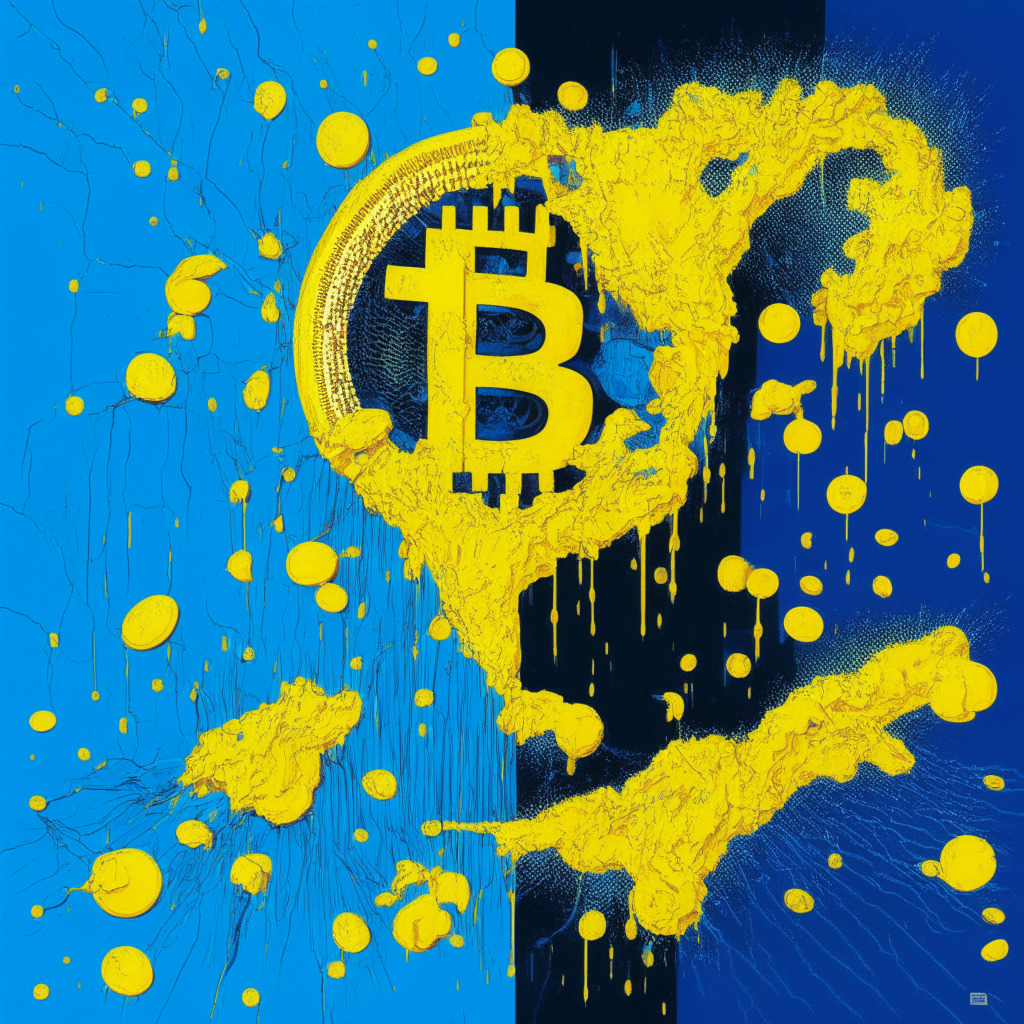Nansen and Kaiko’s partnership aims to provide comprehensive insights into transactions across centralized and decentralized exchanges. This collaboration offers a “holistic view” of the cryptocurrency market, allowing users to access combined datasets and make more informed investment decisions. However, the dominance of centralized exchanges raises concerns about their influence on the entire market.
Search Results for: Kaiko
Crypto Trading Liquidity: Binance’s Dominance, Market Volatility & the Double-Edged Sword of Centralization
“Liquidity centralization in the cryptocurrency market, controlled by major exchanges including Binance and Coinbase, offers advantages like enhanced trading experiences but also increases the risk of market disruptions. Analysts suggest this intense concentration may return volatility to the crypto market, affecting its predictability.”
Market Shivers: Cryptocurrencies Navigate Bearish Waters amid Grayscale Legal Tiff
Bitcoin’s recent dip to $27,240 and Ether’s slight decrease reflects uncertainty following Grayscale’s court victory against the SEC. The court order for SEC to reconsider its rejection of Grayscale’s transformation of GBTC into a spot bitcoin ETF could be a catalyst towards a future for BTC ETFs. Nevertheless, caution is suggested due to potential further downside for Bitcoin if it doesn’t overcome the $28,000 level.
Bitcoin’s Future: The Effects of a Potential ETF and Market Volatility
The average trade size of Bitcoin on crypto exchanges hit a record high following a federal court ruling that encouraged the U.S. Securities and Exchange Commission (SEC) to reconsider Grayscale Investments’ Bitcoin Trust ETF. Large trader activity increased, effectively driving Bitcoin’s price up by over 7%. However, regulatory uncertainties and market volatility continue to pose challenges.
Bitcoin’s Slump Below $26,000: Macroeconomic Factors and The Uncertain Future of Cryptocurrencies
Bitcoin’s recent slump mirrors an overall downturn in the crypto market, influenced by stricter monetary policies aimed at curbing inflation. Despite these challenging conditions and financial uncertainty, the potential introduction of US Bitcoin and Ether futures exchange-traded funds could provide a robust catalyst for the industry.
Decoding the Bitcoin Downturn: Is It a Bubble Burst or a Market Adjustment?
“The recent crypto market plunge differs starkly from previous instances. While Bitcoin’s futures premium started higher, exceeding the 5% neutral threshold, this derivative market shock was rapidly absorbed. The return of BTC futures rates to a 6% neutral-to-bullish position suggests that the drop didn’t dampen market optimism, reducing the likelihood of prolonged price correction.”
Juggling Crypto Progress and Legal Hurdles: A Week in Review
“This week’s key crypto developments include less volatility for BTC and ETH compared to oil, Coinbase’s launch of bitcoin and ether futures trading, and the submission of paperwork for an Ethereum Strategy ETF by Valkyrie Funds. However, Binance Connect experienced a shutdown, illustrating user interface flaws. Also, Ledger facilitated crypto purchases with its PayPal integration, while PayPal launched its Cryptocurrency Hub.”
Surprise in Crypto Territory: Bitcoin and Ethereum Less Volatile than Oil
“The new study by Kaiko reveals surprising reduction in volatility of Bitcoin and Ethereum, now lower than that of oil. Current market trends suggest a maturing cryptocurrency market, with global developments and increased adoption reducing volatility. Regulatory scrutiny and potential approval of a spot ETF could further influence this dynamic.”
Decoding the Decreased Volatility of Bitcoin and Ethereum: A Hopeful Sign or a Major Risk?
The top cryptocurrencies Bitcoin and Ethereum are reportedly less volatile than oil, with BTC and ETH’s volatility at 35% and 37% respectively, while oil’s volatility stands at 41%. This lower volatility might lead to market stability and consistent growth but also signals potential large price movements. Despite similarities, Bitcoin and Ethereum’s differing fundamentals suggest unique trajectories.
Surprising Shift in Market Dynamics: Oil Now More Volatile than Bitcoin and Ethereum
“Cryptocurrency markets are seeing a surprising shift with Bitcoin and Ethereum becoming less volatile than oil. A factor of this decreased volatility is attributed to geopolitical tensions, economic echoes, and maturation of Bitcoin as market adoption increases.”
Shiba Inu Tokens Set the Stage: A Look into Shibarium’s Anticipated Launch and Potential Impact
“The rise of Shiba Inu tokens correlates with the anticipation for Shibarium, a Shiba Inu-based blockchain. Integral to Shibarium is self-sovereign identify (SSI), providing users control over their online personal information. Furthermore, Shibarium’s focus on metaverse and gaming applications, influenced by the upcoming NFT sector, suggest a promising outlook for Shiba Inu’s future.”
PayPal’s Entry in Stablecoin Market: A Game-changer or Another Fizzle?
Despite Bitcoin and Ether’s recent lackluster performance, PayPal’s foray into the stablecoin market hasn’t sparked significant interest. Experts suggest an ETF-triggered catalyst or major crypto development could reignite excitement. Meanwhile, Bitstamp aims to boost its growth by welcoming strategic investors, signaling a potential shift in trading dynamics. Despite these industry moves, traders demonstrate a watch-and-wait approach towards stablecoins.
Binance Bolsters Crypto Market: A Bold Rescue of Curve’s CRV Amid Collapse Fears
After an exploit saw Curve’s native token CRV plummet, market makers at Binance upped their buy orders within 2% of the mid-price from 500,000 to over 1 million CRV. This unusual response to a falling currency is seen by many as a strong supporting move that may have prevented widespread fallout in the decentralized finance market. Despite this, CRV fell by over 14%, sparking alarm across the sector.
Japanese Crypto Landscape: Navigating the Surge of Bitcoin Amidst Market Volatility
Japanese traders are increasingly turning to Bitcoin following recent exchange rate instability. Data shows a significant surge in Bitcoin trade volume from 69% to 80% on Japanese exchanges within the first half of the year, which mirrors a rising appetite within the Japanese markets. Factors affecting this shift include Bitcoin’s status as a hedge against traditional finance, potential regulatory enhancements, and Japan’s current inflation concerns.
The Rise and Uncertainty of Centralized Stablecoins: Balancing Transparency and Dependence
Centralized stablecoins, stabilizing their price against another asset like the U.S dollar, account for 75% of all transactions on centralized crypto exchanges, with TrueUSD (TUSD) and Tether’s USDT taking significant shares. However, amid growth, controversies and transparency issues pose challenges and risks, demonstrating the crypto market’s vulnerability. The future of such stablecoins depends on addressing these vulnerabilities and embracing transparency.
Bitcoin Resilience and Binance.US Liquidity Challenges: A Study in Crypto Market Dynamics
Bitcoin continues to show signs of positive decentralization with over one million wallets each holding at least one Bitcoin. However, Binance.US faces liquidity challenges, with a significant discount on Bitcoin and Tether (USDT) trades due to suspended fiat pipelines. The current market dynamics highlight intriguing movements in future blockchain markets and technologies.
Bitcoin Price Discount on Binance.US: Impact, Future Trajectory, and Legal Disputes
Bitcoin is trading at a $1,000 discount on Binance.US due to potential suspension of USD withdrawals and ongoing legal dispute with the SEC. This impacts Bitcoin’s price as users sell at discounted rates to access funds, reflecting uncertainty among investors and influencing its future trajectory.
Binance Market Share Hits One-Year Low: Analyzing Regulatory Impact & Future Prospects
Kaiko’s report shows Binance’s market share dropped to a one-year low due to increased regulatory scrutiny and competition from traditional finance giants. Despite challenges, Binance’s extensive liquidity pool and trading options help maintain its stance as a preferred exchange for investors.
Bpifrance Dives into Crypto: Boosting French Blockchain Innovation Amid Risks
Bpifrance, a French publicly funded investment bank, enters the crypto space by investing in hardware wallet manufacturer Ledger, exploring Web3 opportunities like Zero-Knowledge (ZK) proofs. The bank aims to support the growing French crypto and blockchain ecosystem, targeting over 450 startups and promoting French innovation in the global blockchain sphere.
Bizarre Bitcoin Spike to $138,000 on Binance.US: Liquidity Crisis or Market Manipulation?
Bitcoin experienced a temporary surge to $138,000 on Binance.US crypto exchange, raising questions about market liquidity and stability. This event highlights concerns over consumer protection, price manipulation, and the need for improved market infrastructure and regulatory oversight in the crypto market.
Crypto Exchanges’ Struggles: Regulators Impact Binance US and Coinbase Market Share
Recent research reveals that Binance US’s market share has dropped significantly since the start of the year, falling from 8% to 1.5%. This reduction is attributed to the high-profile lawsuits against both Binance and its US affiliate, BAM Trading, by the SEC. The unfolding legal drama highlights the challenges faced by cryptocurrency exchanges in an increasingly regulated market.
Exploring the $5 Trillion Tokenization Opportunity: Benefits, Challenges, and Key Players
Tokenization is predicted to reach a massive $5 trillion opportunity over the next five years, with leading forces including stablecoins, CBDCs, private market funds, securities, and real estate. However, regulatory challenges and market volatility could significantly impact its realization.
Regulatory Crackdowns Shift Crypto Traders to OTC Markets: Liquidity Crisis Looms
Crypto traders are increasingly seeking alternative liquidity sources in over-the-counter (OTC) markets due to regulatory crackdowns and reduced market depth on centralized exchanges. This shift towards OTC markets helps traders execute large transactions without relying on thin order books of exchanges, thereby gaining more prominence in the current situation.
Crypto Turbulence Amid Fed Policies and Tether Troubles: Navigating Market Uncertainty
Crypto investors face turbulent market conditions as Bitcoin and major altcoins struggle to recover. Falling liquidity and regulatory concerns add to market jitters, while equities gain momentum. Investors should tread carefully and adopt a long-term strategy during these uncertain times.
eToro Delists Crypto Tokens Amid SEC Actions: Balancing Regulation and Innovation
eToro delists crypto tokens for U.S. customers from July 12 due to recent SEC legal actions against crypto exchanges. The crypto market faces regulatory pressures and market fluctuations, requiring a balance between fostering innovation and ensuring investor protection.
Mass Exodus from Binance US: Analyzing the 80% Liquidity Plunge Amid Regulatory Scrutiny
Recent data reveals an 80% plunge in market depth on Binance US following the SEC lawsuit against Binance and its CEO Changpeng Zhao. This mass exodus of investors highlights the importance of regulatory compliance in the cryptocurrency sector.
Bitcoin Price Dip on Binance.US: Traders Scramble as SEC Freezes Assets
Bitcoin experienced a price dip on Binance.US after announcing plans to transition into a crypto-only platform starting June 13. Traders are urgently liquidating assets due to concerns over halted USD withdrawals, while Binance.US faces the challenge of rebuilding trust and regaining market share.
SEC Actions Against Binance.US Cause Premiums: Managing Risk in an Uncertain Crypto Landscape
Major cryptocurrencies like bitcoin, ether, and USDT are trading at large premiums on Binance.US, indicating deteriorating liquidity amid SEC actions against the platform. Binance.US plans to remove certain trading pairs and pause its OTC trading service to concentrate liquidity and ensure compliance with regulatory requirements. Users must stay informed and vigilant in this dynamic situation.
Binance’s ETH Outflow Surge Amid SEC Charges: Analyzing Market Impact & Regulation Debate
Following the U.S. SEC lawsuit against Binance, the exchange has moved millions of dollars worth of Ethereum (ETH) for staking, resulting in a negative netflow for the cryptocurrency. The legal battle has sparked debate on the need for balanced regulations, affecting the value of Binance’s ecosystem tokens and highlighting the importance of market research for investors.
South Korean Crypto Traders Embrace XRP and Diverse Altcoin Market: Ripple-SEC Case Impact
Latest data reveals that XRP is the most-traded cryptocurrency in South Korea apart from Bitcoin and Ethereum, capturing 12% of non-BTC/ETH trading volume. The country prioritizes lucrative opportunities within diverse digital assets, establishing itself as a major player in the global crypto market.
Binance Market Share Shrinks by 25%: Regulatory Pressure and Market Conditions to Blame
Binance’s market share has dropped by 25% due to increased regulatory scrutiny from the US and termination of a zero-fee trading campaign. Other crypto exchanges, such as Huobi and OKX, have witnessed increased market shares since March.
Tether’s USDT Reclaims All-Time High Market Cap Amid Stablecoin Controversy and Competition
Tether’s stablecoin USDT has regained its all-time high market cap of $83.2 billion, despite challenges in the stablecoin market and criticism over its reserve transparency. USDT’s perceived safety from U.S. regulators and its growing use for global payments contribute to this resurgence, highlighting peg stability as a priority for users.































